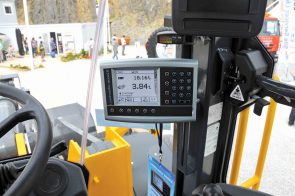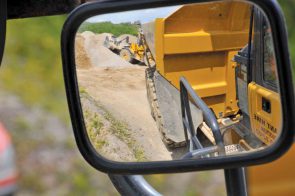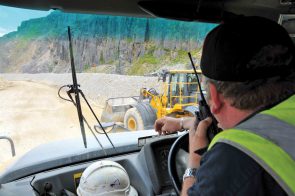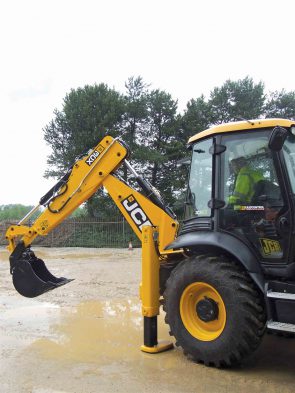Europe’s construction equipment manufacturers face major challenges
First published in Global Report: Construction Equipment 2016 as Challenges ahead for Europe’s leading machinery builders
Europe’s construction equipment industry is facing tough challenges at a time of stricter legislation, confusion over certain standards and difficult market conditions – Mike Woof writes
The construction equipment sector in Europe is undergoing a major transition as new regulations come into play, requiring manufacturers to invest heavily in new technologies. Meanwhile it is also experiencing low sales volumes, compared with the peaks of just a few years ago and increasing pressures on suppliers. These factors, as well as others, are combining to make Europe’s construction equipment market highly challenging at present, although it is not without its economic benefits for participants.
The slowdown in machine sales of the last few years has come at a time when manufacturers are gearing up to develop new low emissions technologies. These have been required to meet tougher environmental legislation in Europe as well as North America, with the Tier 4 Final/Stage IV requirements having been introduced. Complex and costly, these technologies have cut tailpipe emissions for construction machines but resulted in increased purchase costs for many models.
However with other markets looking to introduce similar emissions controls in the future, the European construction equipment manufacturers will benefit economically in the long term from the development of this sophisticated technology. The China Stage 3 requirements are now being phased in and are broadly comparable with those of Tier 3/ Stage III for North America and Europe, with the prospect of further emissions stages in the future. Other international markets too will implement Tier 3/Stage III emissions legislation while China’s current focus on reducing atmospheric pollution will most likely see it introducing further legislation similar to the European/US Stage IV/Tier 4 Final requirements in the not too distant future. And with the extended service intervals and lower fuel consumption of the Stage IV/Tier 4 Final compliant machines, equipment customers are also seeing the economic benefits from buying these new, low emission machines over the mid-long term.
However the pace of technological development is continuing, particularly for Europe. Manufacturers supplying customers in Europe also face the need of meeting further legislation, with the planned Stage V requirements coming into action in a few years. This is of note as it will take Europe ahead of the US in terms of emissions legislation for the first time.
Manufacturers supplying machines into Europe also face the possibility of having to conform to other legislation as well. The problem however is that some of the legislation has yet to be drafted, leaving a huge measure of uncertainty. One of the key issues requiring clarification in this respect is with visibility; what the operator can see from the work station.
There is a question mark over the current standard, following a submission made to the European Parliament some years ago. According to Malcom Kent, senior technical consultant for the UK’s Construction Equipment Association (CEA), this petition claimed that the standard that earthmoving machinery manufacturers were using in the design of machinery, ISO 5006, did not provide a sufficient level of safety. After a process of investigation the European Commission came to the conclusion that the petition was indeed correct and published a Decision, stating that the standard had been deemed inadequate. This meant that the European Commission’s approval of the standard was being withdrawn.
Confusingly, although the standard still exists, manufacturers can no longer rely on it as a means to claim that their machines offer the necessary visibility to make them safe.
Kent explained that there are two areas where visibility is assessed under the 2006 edition of the standard: firstly on a 12m circle around the machine at ground level, and secondly on a 1.5m-high post moved around a rectangle set 1m out from the footprint of the machine. The detailed requirements vary depending on machine type and size but the principles are the same for all. There is no requirement to be able to see anything at all between 1m and 12m from the machines, although in practice the operator would be able to see a great deal in this range. However Kent explained that the key criticism of the standard by the petition was that significant blind spots behind the machine were allowed, leading to a risk of accidents.
Kent explained that this leaves questions as to whether a machine is safe enough for use. As a result, manufacturers have to carry out a risk assessment that covers the type of equipment, its size, how it moves and how fast it operates, as well as how any work tools it may be fitted with operate and, overall, how the machine is used. Clearly this is complex but it is the process every manufacturer now needs to undergo given that the official European standard has been recognised as being unfit for purpose.
This absence of a suitable standard also means that Europe’s safety authorities are having to establish guidance for manufacturers, as well as contributing to the establishment of a new standard. Kent said that in the UK, the Health and Safety Executive (HSE), has issued a guidance document, which is available for download from its website and covers some of the key issues in brief.
But Kent warned that the future for the new standard is far from clear. Because the standard will be an international one, some of the influence for its development will come from outside Europe. And he said that some countries will be unwilling to require manufacturers to install construction machines with extensive tools to boost visibility such as additional mirrors and cameras. Agreement has to be reached internationally on how the existing standard can be amended but this may prove difficult. And it is even possible that once a new standard has been set, it may also prove unfit for purpose according to the definitions set by the European parliament.
Europe may opt to set its own standard for visibility as this would be most likely to meet the needs set out by the European Commission but Kent commented that the work carried out so far seems to be missing the necessary target.
As a result it could be several years until a new and acceptable standard for machine visibility has been set, leaving both equipment manufacturers and users in something of a vacuum in the meantime. For the moment, manufacturers and machine users can at least utilise the guidance from bodies such as the HSE. This suggests reviewing and updating risk assessments and also regularly checking on new technical developments in boosting visibility. The HSE guidance also says that interested parties should keep abreast of progress with regard to revisions to the standard. But Kent commented that this last is next to impossible since progress is sporadic and seems to be going in different directions simultaneously.
The HSE guidance suggests the addition of visibility maps to machine instructions that show any blind spots around a machine. However, Kent commented that since instruction manuals are often ignored by users it is debatable as to whether this will improve safety. Some equipment customers are asking manufacturers what is being done about visibility while others are taking their own measures by fitting additional mirrors or CCTV equipment. In taking this latter approach, Kent warned that these customers are also taking a greater responsibility with regard to risk assessment.
However, given that the standard is considered unfit for purpose, both manufacturers and equipment users in Europe have little option but to try and follow the guidance from bodies such as the HSE. How long it will take to develop a new standard is unclear but Kent warned that this complex process cannot be achieved quickly.
Economically, the need for the new visibility standard comes at a tough time for manufacturers of construction equipment in Europe as well as wider afield. Sales of construction machines suffered a major blow right across Europe following the global slump some years ago.
That said, some territories within Europe are seeing a recovery. David Phillips, managing director of Off-Highway Research discussed some of the key factors affecting Europe’s machine market during the recent Construction Equipment Association (CEA) annual general meeting held in London. He said, “We see dramatic effects of the crash of 2008 and 2009.”
Phillips commented that the brakes are still being applied to construction machine sales in Europe and for a number of reasons. He said, “It’s the uncertainty that the market doesn’t like. We are seeing some positives, but there are a lot of potholes in the road. It’s that lack of business confidence that is depressing the industry.”
Phillips explained that market performance varies across Europe however and commented, “Southern Europe is still weak. The UK, France and Germany are the powerhouses in Europe right now.”
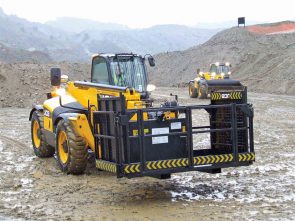 The telehandler is one of the versatile machines that is contributing to the sales decline of the backhoe loader and also now represents a major portion of JCB’s business
The telehandler is one of the versatile machines that is contributing to the sales decline of the backhoe loader and also now represents a major portion of JCB’s businessLooking ahead to the future, Phillips said he’d been asked to make long-term predictions as to the state of the construction equipment market by one major manufacturer. He commented, “I hesitate to forecast more than six months ahead,” although he did outline some possible directions trade could take to the firm’s executives.
Clearly there are some key trends that are being seen in this industry, with sales of certain types of equipment increasing and others declining over the long-term. A number of machine types have long held key slots in terms of overall equipment demand and Phillips said, “It’s important to see how important the excavator market is.”
Other categories of machines are becoming less important to overall machine sales. He continued, “Demand for backhoe loaders has declined significantly. They’re being replaced by skid steer loaders, mini excavators, telehandlers and wheeled excavators.”
The UK has long been a good market for the versatile backhoe loader, so much so that it formed the basis for JCB’s growth as an international player in the construction equipment market. The machines do sell well in Italy and Turkey but elsewhere in Europe, the backhoe loader is less popular (internationally, the US and India remain key markets for backhoe loaders and the latter, particularly so). In France and Germany, the equally versatile wheeled excavator is popular for instance and is able to handle many of the tasks that in the UK, Italy or Turkey, would be carried out by a backhoe loader. Other versatile machines such as telehandlers, mini excavators, compact wheeled loaders and skid steer loaders and compact tracked loaders have also gradually helped to erode sales of the backhoe loader in Europe. It is of note too that JCB’s overall business has long placed a greater reliance on the crawler excavator while its strong position in the telehandler market is also now far more important for its overall European market share and revenue.
This change in demand for different types of machines can be seen in the shifting market share figures for Europe compiled by Off-Highway Research. Crawler excavators weighing 6tonnes and over accounted for 17% of total machine sales in Europe in 2007, while mini excavators accounted for 33% of machine sales. The market for telehandlers stood at 15% of machine sales, with wheeled loaders at 12%. The data shows that sales of backhoe loaders accounted for just 7% of Europe’s equipment market with sales of skid steer loaders at 6% and wheeled excavators at 5%.
The comparison with the figures compiled by Off-Highway Research for 2014 however is marked. Sales of mini excavators grew to 36% of the market while sales of telehandlers grew to 18% of the market, equalling sales levels for crawler excavators. Sales of wheeled loaders grew to 15% of the market and wheeled excavators saw a slight upturn to 6%, however sales of backhoe loaders and skid steer loaders both dropped to account for 2% apiece.
Phillips admits that accurate future predictions are hard to make but believes that sales of backhoe loaders will not recover and for 2019, will comprise around 2% of the European equipment market. Sales of skid steer loaders will also be around 2% of the European market (these machines are more popular in the US), with wheeled excavators accounting for 5%. However, Phillips predicts that sales of mini excavators will retain their strong acceptance at 36% of the European market for construction machines, while sales of crawler excavators and telehandlers will be similarly stable, again at 18% apiece.
The trend in overall numbers of construction machines sold within Europe has changed considerably since 2000. The new millennium started with a period of fairly consistent sales in Europe. Total construction machine unit sales were around 152,000 in 2000, around 148,000 in 2001, about 140,000 in 2002 and 138,000 in 2003. After this point machine sales started to increase, gradually at first with around 152,000 units in 2004 and then ever more sharply, hitting around 164,000 units in 2005 and then about 188,000 units in 2006.
Construction machine sales then peaked in Europe in 2007 at around 212,000 units and then plummeted following the global economic crash to some 162,000 units in 2008 and just 88,000 units in 2009. Since the crash of 2007/2008, sales in Europe have recovered to around 132,000 units in 2011, dropping to around 118,000 in 2012 and 112,000 units in 2013 and then improving again with around 120,000 units being sold in 2014 and 124,000 for 2015. The average number of units sold in Europe for the period from 2010-2014 is around 116,407, according to Off-Highway Research.
Looking ahead, Phillips predicts sales of around 129,000 units for 2016, 130,000 units for 2017, 129,000 units for 2018 and 132,000 units for 2019. The average no of units sold/ year for the 2015-2019 period could be in the order of 130,695 according to Phillips’ predictions, although he has been keen to stress that these are based on his best guess analysis.
Compared against the unit sales, the total value of machines traded provides further insight into the way the construction equipment market has changed in recent years. Overall sales of construction machines in Europe totalled some US$20 billion in 2007 according to Off-Highway Research, plunging downwards immediately afterwards but then recovering to $12 billion in 2011.
The data shows a fairly steady rate of business for construction machines afterwards with total sales of around $12 billion in 2012 and 2013, $13 billion in 2014 and back down to $12 billion for 2015. Phillips does not believe the European market will see a return to the massive spike in sales, at least for some time.
Looking further ahead, Philipps is reluctant to put an accurate figure on construction machine sales in Europe as there are so many factors that could affect the market. However he said that sales could well remain fairly stable and reach in excess of 130,000 units in 2019, equivalent to a total sales turnover of some $13 billion.
Europe’s position in the global market for construction machines has declined in importance for manufacturers. In terms of global demand for machines, European sales accounted for 21% of all construction equipment in 2007 but fell to 12% in 2011 following the slump, increasing slightly to 15% for 2014. Phillips believes that Europe could account for 16% of machine sales in 2019.
Clearly production output for construction machines in Europe has followed a similar pattern to equipment sales. Much of Europe’s production of construction machines is used in this market, with a much smaller percentage being for export.
From 2000 through to 2004, machine production in Europe was fairly consistent. Output stood at around 160,000 units in 2000, dropping to around 151,000 in 2001 and around 147,000 in 2002. A turnaround in sales was notable for 2003 with output of around 150,000 and then beginning a climb first to around 173,000 in 2004, around 185,000 units in 2005 and some 205,000 machines in 2006.
Production output for construction machines in Europe has adapted to the drop in demand following the economic crisis, after output hit its peak of around 242,000 units in 2007, dropping quickly to around 71,000 units in 2009. The average production output for the 2005-2009 period was 180,805 units, although the huge peak in demand in 2007 was followed by sharp and rapid decline, with output plummeting to its depth in 2009.
Production recovered slightly in 2010 to around 95,000 units and then climbed quickly to 152,000 units for 2011, before dropping back in 2012 to about 145,000 machines and 2013 to around 132,000, before recovering again in 2014 to around 150,000 units. The average production rate for the 2010-2015 period has been 141,015 units.
The difference in demand for construction machines in the varying European countries has been marked. In 2007 the UK accounted for 19% of sales of construction equipment in Europe, with France and Germany accounting for 18% apiece. Meanwhile Italy was the next largest market at 14% of European sales and Spain at 10%, with the rest of Europe combined accounting for the remaining 21%.
For 2014 the collapse of the economy in Southern European countries could be plainly seen with the demand for construction machines. In 2014 the UK accounted for 26% of machine sales in Europe with Germany close behind at 25% and France at 19%. Italy meanwhile accounted for just 6% and the rest of Europe the remaining 24%.
Looking ahead for 2019, Phillips believes the UK and Germany will account for 22% of construction equipment sales apiece, while France will be at 19% of the total market. Sales to Italy will recover to 11% with the remaining countries accounting for 26% of machine demand.
For construction machinery manufacturers and customers in Europe, the future remains uncertain and it is clear that there are still many questions to be answered.
Data on Europe’s construction machinery sales reproduced with kind permission of Off- Highway Research.
Companies in this article
JCB

